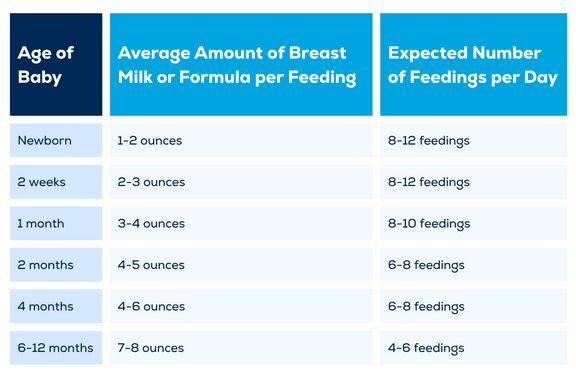Newborn Care Essentials
The early days of caring for your newborn are filled with excitement, challenges, and a lot of learning. Understanding the basics can help ease the transition as you care for your child.
Newborn Feeding
Creating a consistent feeding routine helps support your baby’s growth, development, and sense of comfort. Whether you choose to breastfeed, formula feed, or a combination of both, the most important thing is that your baby is getting the nourishment they need to thrive.
Every baby is different. How much and how often they feed will vary — and that’s okay. As your baby grows, their feeding needs will naturally change. While there’s no one-size-fits-all approach, the chart below offers general guidance for feeding in the first year:

Babies who are breastfed often feed more frequently than those who are formula-fed. No matter how you feed your baby, try not to let more than four hours pass between feedings, especially in the early weeks. Sometimes that means gently waking your baby to feed.
Feeding can come with questions and challenges, and that’s completely normal. For helpful breastfeeding tips on latch, positioning, and milk supply, visit our breastfeeding health topic.
You can also connect with our team of board-certified Lactation Consultants for personalized guidance and support along the way.
Newborn Sleep
Creating a safe sleep environment for your newborn is crucial in reducing sleep-related risks like Sudden Infant Death Syndrome (SIDS). Safe sleep for babies means:
- Placing your baby on their back to sleep
- Keeping the crib in your room (but not in your bed) for the first 6 months
- Using a firm surface with a tight-fitting sheet
- Keeping the crib free of soft bedding, pillows, or stuffed animals
For more information on newborn sleep safety, check out our Sleep Safety Guide.
Newborn Bathing and Hygiene
Your baby’s first bath is a sweet milestone, and it’s natural to have questions about when and how to begin. It’s generally recommended to wait until the umbilical cord stump has fallen off — usually within the first one to two weeks after birth — before giving a full bath. Until then, gentle sponge baths are a great way to keep your baby clean and comfortable.
In those early weeks, babies only need to be bathed one to two times a week. More frequent bathing can dry out their sensitive skin. It’s also best to hold off on lotions or oils at this stage, as these can sometimes cause irritation or rashes.
Keeping your baby clean also includes regular nail care and proper diaper hygiene:
- Trim their fingernails regularly to help prevent accidental scratches.
- Change diapers often, making sure to gently wipe away all urine and stool.
- Let the diaper area dry completely before putting on a clean diaper.
- If you notice redness, clean the skin gently and apply a thick layer of diaper cream before the next diaper goes on.
These small steps help keep your baby’s skin healthy and protected — and give you peace of mind as you settle into your new routine.
